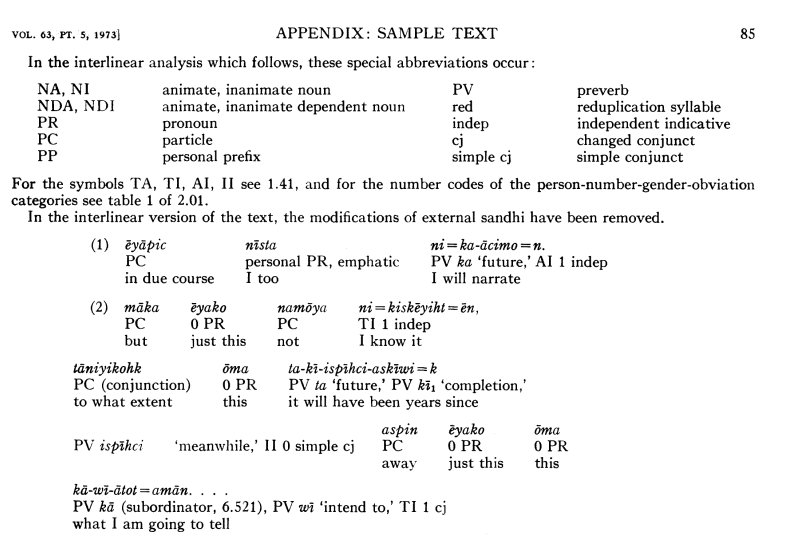Sample glosses
1547olmos-nahuatl-231.png
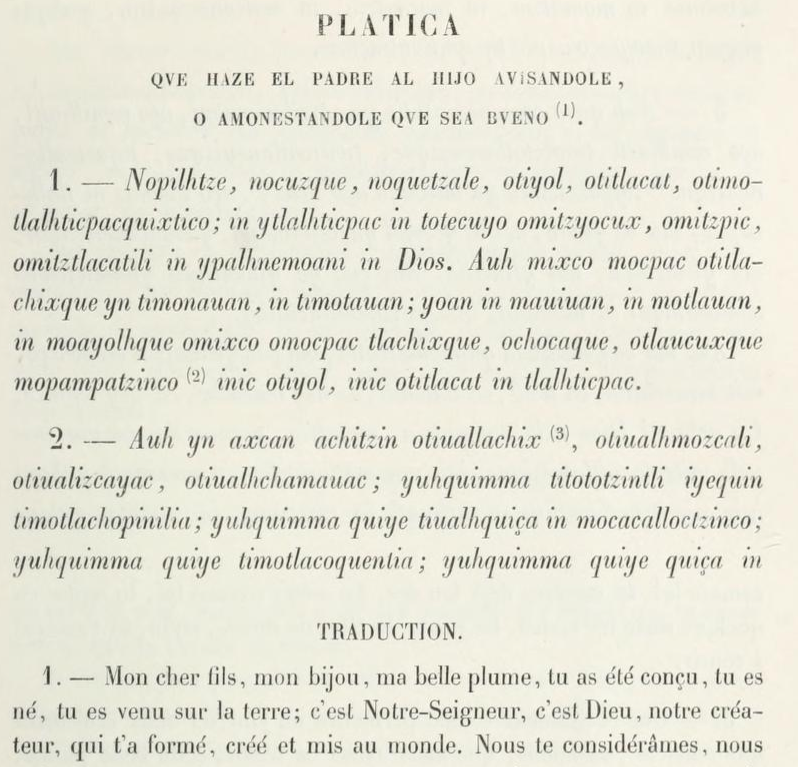
/*
Comments:
Siméon, the 19th century French editor of the text, and translator in the case of this Nahuatl excerpt, explains: "Nous l'avons accompagné d'une traduction française aussi littérale que possible." (We have accompanied the text with a French translation which is as literal as possible.)
levels of transcription
2
type
parallel text
style
phrase to (litearal) phrase
readability
high
analysis
none
apparatus
sparse prose footnotes from editor
sentence delimiters
seemingly typical French punctuation at time of publication (1875)
morpheme delimiters
none
*/
1. — Nopilhtze, nocuzque, noquetzale, otiyol, otitlacat, otimotlalhticpacquixtico; in ytlalhticpac in totecuyo omitzyocux, omitzpic, omitztlacatili in ypalhnemoani in Dios.
1. — Mon cher file, mon bijou, ma belle plume, tu as été conçu, tu es né, tu es venu sur la terre; c'est Notre-Seigneur, c'est Dieu, notre créateur, qui t'a formé, créé et mis au monde.
1835hurwitz-hebrew-55.png

וַיִּקְרָ֨א אֱלֹהִ֤ים׀ לָאוֹר֙ י֔וֹם וְלַחֹ֖שֶׁךְ קָ֣רָא לָ֑יְלָה וַֽיְהִי־עֶ֥רֶב וַֽיְהִי־בֹ֖קֶר י֥וֹם אֶחָֽד׃ פ
And-he-called God to-the-light day and-to-the-darkness he-called night. And-he-was evening and-he-was morning day one.
5 wayyiqərā’ ’ĕlōhîm| lā’wōr ywōm wəlaḥōšeḵə qārā’ lāyəlâ wayəhî-‘ereḇ wayəhî-ḇōqer ywōm ’eḥāḏ: f
/*
A grammar of the Hebrew language
This typographical tour-de-force, from is very concise interlinearization of Biblical Hebrew.
Comments:
levels of transcription
2
type
text
style
word to word
readability
very high
analysis
none in this text, elsewhere uses outline font to indicate inflections
apparatus
footnotes
directionality
right to left
sentence delimiters
apparently colon used for sentence delimiter in Mayan and Englsih
morpheme delimiters
dashes in source only
*/
1894berry-greek-iii.png

/*
Comments:
This text gives an explicit description of a method of interlinear description.
An interesting feature is that the source text (New Testament Greek, in this
case) is modified (spaces are replaced with dashes) in order to avoid certain
types of reordering in the translation tier.
levels of transcription
2
type
text
style
word to word
readability
high
analysis
none
apparatus
prose footnotes, marginal free translation
sentence delimiters
standard punctuation
morpheme delimiters
none
*/
1905burkitt-kekchi-273.png
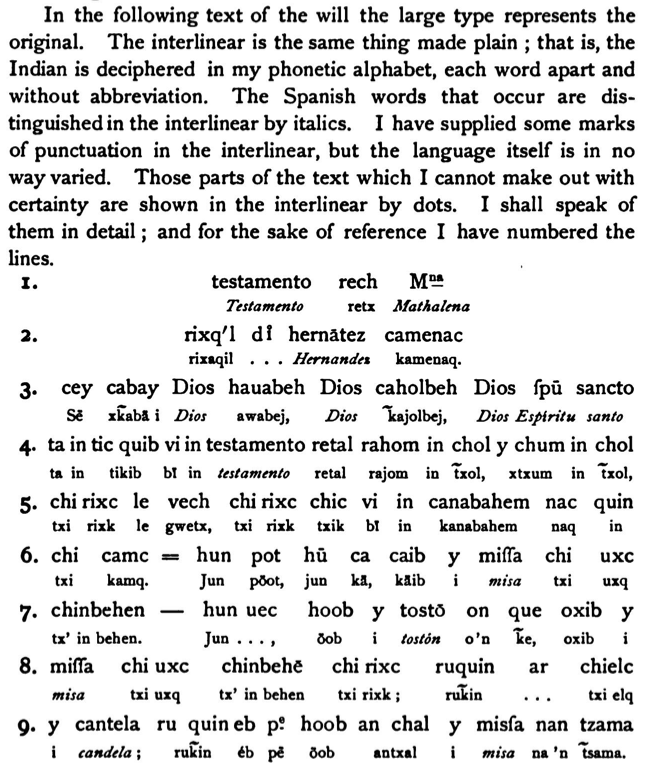
/*
Comments:
levels of transcription
2
type
text
style
transcription to transcription?
readability
high (depends on the reader! -- if they know Kekchi, very high!)
analysis
none
apparatus
prose footnotes with line number references
sentence delimiters
semicolon, long dash and long equals sign used but meaning unclear
morpheme delimiters
dashes in source only
*/
1910endle-kachari-73.png

/*
Comments:
The Kacháris
This excerpt from a 1910 pedagogical grammar of Kachari (Tibeto-Burman)
demonstrates how variant styles of glossing can depend on the context
in which they are quoted. Here three examples demonstrating the Kachari
comparative, but only the final example uses vertical alignment. Working
out the word correspondences here requires either familiarity with the
preceding content in the grammar, general familiarity with the language,
or a considerable effort of decipherment.
levels of transcription
2
type
pedagogical grammar
style
word to word (vertical) and phrase to phrase (horizontal)
readability
low
analysis
partial
apparatus
prose footnotes
sentence delimiters
paragraphs or long dash
morpheme delimiters
dashes in source
*/
1910finck-turkish-83.png
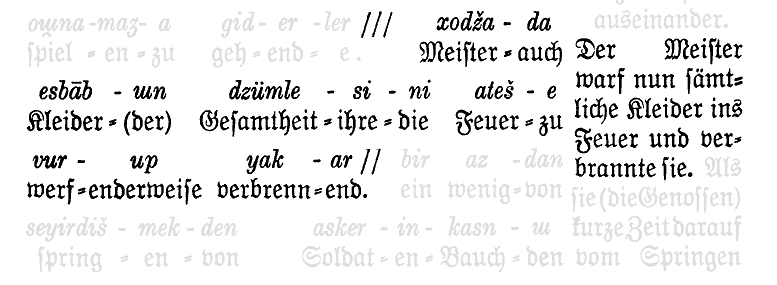
{ "wtf" : "WTF"}
/*
dža-da
Meister=auch
esbāb-ın
Kleider=(der)
dzümle-si-ni
Gesamtheit=ihre=die
ateš-e
Feuer=zu
vur-up
werf=enderweise
yak-ar
verbrenn=end
Der Meister warf nun sämtliche Kleider ins Feuer und verbrannte sie.
*/
1910finck-turkish2german-115.png
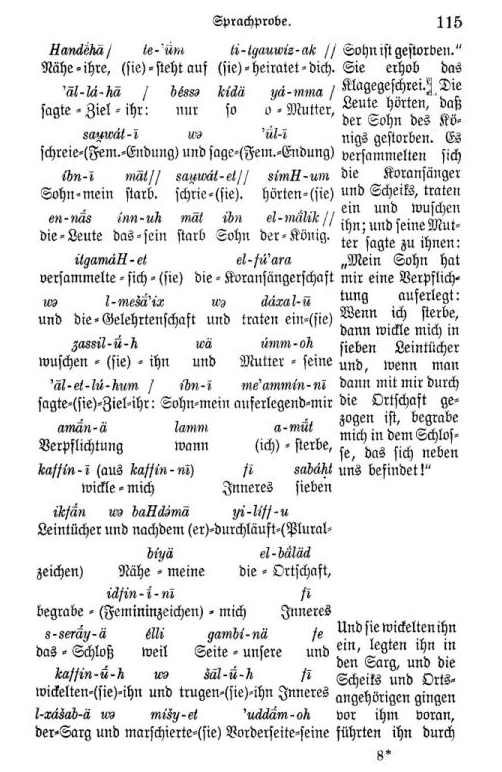
xodža-da
Meister=auch
esbāb-ın
Kleider=(der)
dzümle-si-ni
Gesamtheit=ihre=die
ateš-e
Feuer=zu
vur-up
werf=enderweise
yak-ar
verbrenn=end
Der Meister warf nun sämtliche Kleider ins Feuer und verbrannte sie.
1910sapir-takelma-294.png
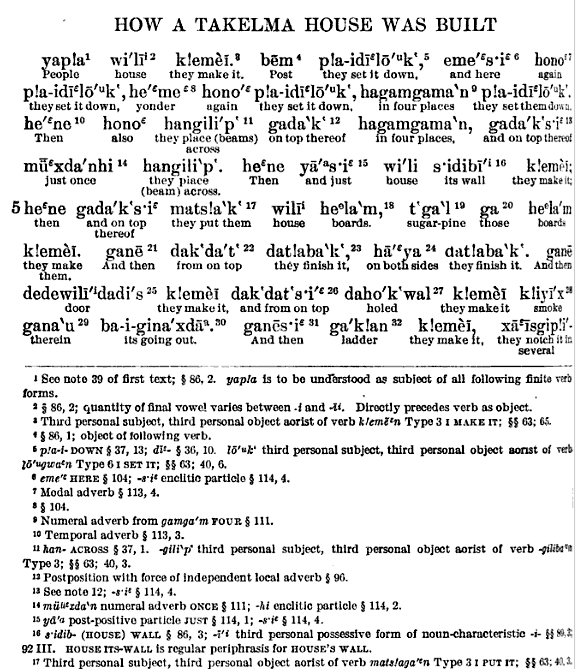
/*
Sapir's Takelma is highly informative down to the level of the
morpheme, but is not explicitly or consistently marked as such —
in the running text, a paraphrastic word-to-phrase style is used, but
individual source words are indexed to refer to extensive footnotes.
Interestingly, these footnotes are often quite repetitive. I suspect
that it is this sort of repetition which would lead to the adoption of
extensive abbreviation in the use of grammatical category labels in
the morphological tier of annotation.
Comments:
levels of transcription
2
type
text
style
word-to-phrase (paraphrase), mostly
readability
medium
analysis
in footnotes
apparatus
extensive and repetitive footnotes
sentence delimiters
English-style punctuation
morpheme delimiters
dashes occasionally in some source words
*/
1915bloomfield-language-157.png
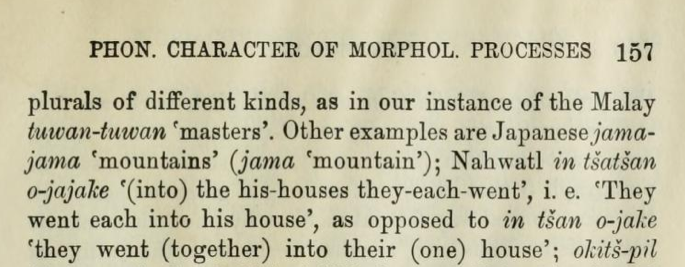
/*
Comments:
levels of transcription
2
type
text
style
word to word
readability
high
analysis
none
apparatus
prose footnotes
sentence delimiters
apparently colon used for sentence delimiter in Mayan and Englsih
morpheme delimiters
dashes in source only
*/
1915bloomfield-language-192.png

/*
As Lehmann notes, Bloomfield himself, [while considered a primary
proponent of the idea of the morpheme], did not always consistently
indicate morpheme-to-label mappings. In this Turkish example extracted
from an early edition of his text Language, he transcribed the
source sentence phonetically, and translated in a paraphrastic style
comparable to Sapirs'. But nowhere is there a clear indication of
how the semantics of the paraphrasis are intended to be mapped onto
the individual morphemes of the Turkish words, or even what those
morphemes are.
Comments:
levels of transcription
3
type
inline example
style
word to word with free translation
readability
high as prose, difficult as a gloss
analysis
none
apparatus
prose footnotes
sentence delimiters
apparently colon used for sentence delimiter in Mayan and Englsih
morpheme delimiters
dashes in source only
*/
1921tozzer-mayan-115.png
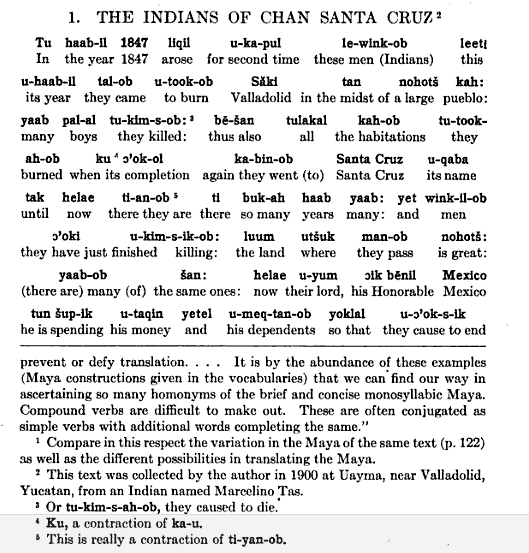
A run-of-the-mill word-to-word interlinear gloss, this one is
remarkable only for its less-than-detailed footnotes (compare Sapir's
Takelma footnotes produced 11 years earlier) and the fact that
only the source words are broken into morphemes.
It is also exemplifies some of the dangers of relying a word-to-word
alignment in this style of paraphrastic translation:
Tu haab-il 1847 liqil u-ka-pul le-wink-ob leeti
u-haab-il tal-ob u-took-ob Săki tan nohot$ kah:
yaab pal-al tu-kim-s-ob: bĕ-šan tulakal kah-ob tu-took-ah-ob
ku {open-o}{prime}ok-ol ka-bin-ob Santa Cruz u-qaba
tak helae ti-an-ob ti buk-ah haab yaab: yet wink-il-ob
{open-o}{prime}oki u-kim-s-ik-ob: luum ut$uk man-ob nohot$:
yaab-ob šan: helae u-yum {open-o}ik bĕnil Mexico
tun šup-ik u-taqin yetel u-meq-tan-ob yoklal u-{open-o}{prime}ok-s-ik
Tu
In
haab-il
the year
1847
1847
liqil
arose
u-ka-pul
for second time
le-wink-ob
these men (Indians)
leeti
this
u-haab-il
its year
tal-ob
they came
u-took-ob
to burn
Sa{breve}ki
Valladolid
tan
in the midst of
nohot$
a large
# alignment here unclear: [ in the midst of a large pueblo / Sa{breve}ki tan nohot$ kah: ]
kah:
pueblo:
yaab
yaab
pal-al
tu-kim-s-ob:
be{breve}-$an
tulakal
kah-ob
tu-took-ah-ob
ku
{open
o}{prime}ok-ol
ka-bin-ob
Santa
Cruz
u-qaba
tak
helae
ti-an-ob
ti
buk-ah
haab
yaab:
yet
wink-il-ob
{open
o}{prime}oki
u-kim-s-ik-ob:
luum
ut$uk
man-ob
nohot$:
yaab-ob
$an:
helae
u-yum
{open
o}ik
be{breve}nil
Mexico
tun
$up-ik
u-taqin
yetel
u-meq-tan-ob
yoklal
u-{open-o}{prime}ok-s-ik
/*
Comments:
levels of transcription
2
type
text
style
word to word
readability
high
analysis
none
apparatus
prose footnotes
sentence delimiters
apparently colon used for sentence delimiter in Mayan and Englsih
morpheme delimiters
dashes in source only
*/
1965oswalt-dictionary-extract.png

/*
Comments:
levels of transcription
2
type
text
style
word to word
readability
high
analysis
none
apparatus
prose footnotes
sentence delimiters
apparently colon used for sentence delimiter in Mayan and Englsih
morpheme delimiters
dashes in source only
*/
1970golla-hupa-295.png

1972-applegate-531.png
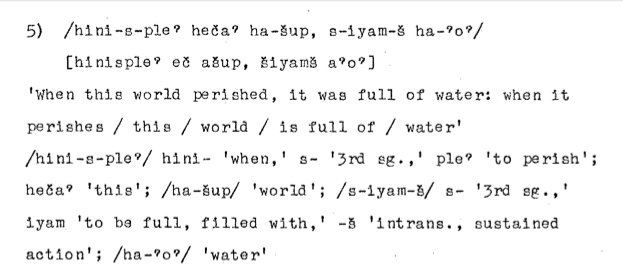
/hini-s-pleʔ hečaʔ ha-šup, s-iyam-š ha-ʔ-oʔ/
[hinispleʔ eč ašup, siyamš aʔoʔ]
'When this world perished, it was full of water: when it perishes / this / world / is full of / water'
hini-s-pleʔ
hini-
when
s-
3rd sg.
ple{glottal}
to perish
hečaʔ
this
ha-šup
world
s-iyam-š
s
3rd sg
iyam
to be full, filled with
-š
intrans., sustained action
ha-ʔ-oʔ
water
1973wolfart-plainscree-85.png
